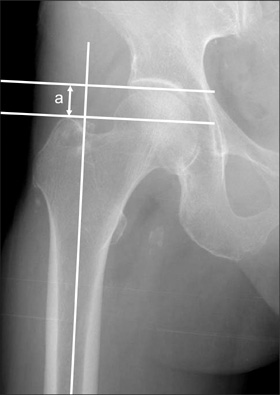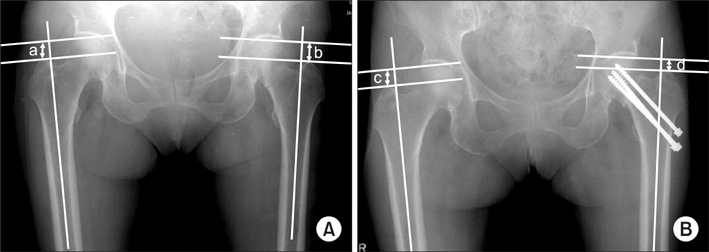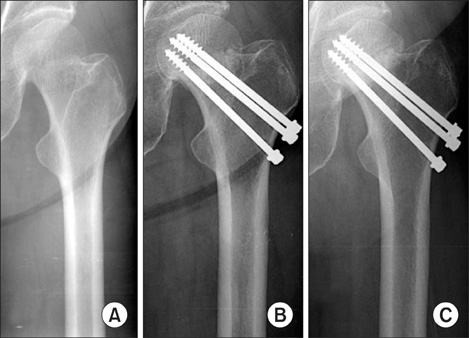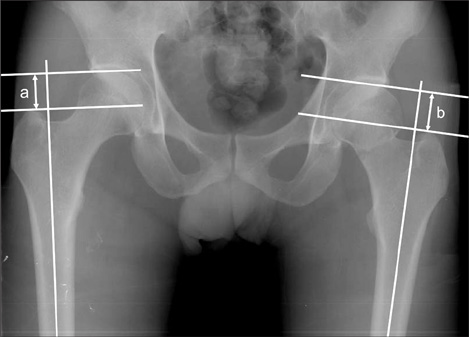Progression of a Fracture Site Impaction as a Prognostic Indicator of Impacted Femoral Neck Fracture Treated with Multiple Pinning
- Affiliations
-
- 1Department of Orthopedic Surgery, Seoul National University College of Medicine, Seoul, Korea. oskim@snu.ac.kr
- 2Department of Orthopedic Surgery, Seoul National University Boramae Hospital, Seoul, Korea.
- 3Department of Orthopedic Surgery, Seoul National University Hospital, Seoul, Korea.
- KMID: 1245400
- DOI: http://doi.org/10.4055/cios.2012.4.1.66
Abstract
- BACKGROUND
We evaluated the clinical and radiologic results of impacted femoral neck fractures treated with multiple pinning and determined the influence of the progression of impaction at the fracture site on clinical outcome.
METHODS
There were 34 patients with a mean age of 65.5 years. The mean follow-up period was 3.4 years. Progression of fracture site impaction was measured using an articulo-trochanteric distance index and the percentage decrease in the articulo-trochanteric distance index between follow-up intervals. The failure of treatment was clarified as non-union and avascular necrosis. Other characteristics of the patients, including mean waiting time for surgery, preoperative Singh index score, and body mass index, were also measured to evaluate the influence on the clinical outcome of surgery.
RESULTS
There were 6 fractures which were not treated successfully (3 non-union, 8.8% and 3 avascular necrosis, 8.8%). The mean percentage decrease of the articulo-trochanteric distance index within the first 6 weeks after surgery was 4.5% in the successful group and 25.1% in the failure group (p < 0.001). There was also a significant mean percentage decrease in the articulo-trochanteric distance index between 6 weeks and 3 months (p < 0.001).
CONCLUSIONS
Primary stabilization with Knowles pins for impacted femoral neck fractures had a reasonable clinical outcome with low morbidity. Despite a significant difference of a mean percentage decrease in the articulo-trochanteric distance index between the successful group and the failure group, we could not verify it as a risk factor for failure of treatment because the odds ratio was not statistically significant.
MeSH Terms
Figure
Cited by 3 articles
-
Risk Factors for Neck Shortening in Patients with Valgus Impacted Femoral Neck Fractures Treated with Three Parallel Screws: Is Bone Density an Affecting Factor?
Yerl-Bo Sung, Eui-Yub Jung, Kyung-Il Kim, Soo-Yeon Kim
Hip Pelvis. 2017;29(4):277-285. doi: 10.5371/hp.2017.29.4.277.Could We Prevent Displacing the Undisplaced Fracture Neck of Femur? To the Editor
Anoop C. Dhamangaonkar
Clin Orthop Surg. 2012;4(2):171-172. doi: 10.4055/cios.2012.4.2.171.Surgical Outcomes of Internal Fixation Using Multiple Screws in Femoral Neck Fractures with Valgus Impaction: When Should We Consider Hip Arthroplasty? A Retrospective, Multicenter Study
Nam Hoon Moon, Won Chul Shin, Jae Hoon Jang, Han Ul Seo, Jung Yun Bae, Kuen Tak Suh
Hip Pelvis. 2019;31(3):136-143. doi: 10.5371/hp.2019.31.3.136.
Reference
-
1. Bentley G. Impacted fractures of the neck of the femur. J Bone Joint Surg Br. 1968. 50(3):551–561.2. Raaymakers EL. The non-operative treatment of impacted femoral neck fractures. Injury. 2002. 33:Suppl 3. C8–C14.3. Damany DS, Parker MJ. Varus impacted intracapsular hip fractures. Injury. 2005. 36(5):627–629.
Article4. Chen WC, Yu SW, Tseng IC, Su JY, Tu YK, Chen WJ. Treatment of undisplaced femoral neck fractures in the elderly. J Trauma. 2005. 58(5):1035–1039.
Article5. Parker MJ, White A, Boyle A. Fixation versus hemiarthroplasty for undisplaced intracapsular hip fractures. Injury. 2008. 39(7):791–795.
Article6. Jarolem KL, Koval KJ, Zuckerman JD, Aharonoff G. A comparison of modified Knowles pins and cannulated cancellous screws for the treatment of nondisplaced or impacted femoral neck fractures. Bull Hosp Jt Dis. 1993. 53(3):11–14.
Article7. Raaymakers EL, Marti RK. Non-operative treatment of impacted femoral neck fractures: a prospective study of 170 cases. J Bone Joint Surg Br. 1991. 73(6):950–954.
Article8. Otremski I, Katz A, Dekel S, Salama R, Newman RJ. Natural history of impacted subcapital femoral fractures and its relevance to treatment options. Injury. 1990. 21(6):379–381.
Article9. Leitch JM, Paterson DC, Foster BK. Growth disturbance in Legg-Calve-Perthes disease and the consequences of surgical treatment. Clin Orthop Relat Res. 1991. (262):178–184.
Article10. Shimizu T, Miyamoto K, Masuda K, et al. The clinical significance of impaction at the femoral neck fracture site in the elderly. Arch Orthop Trauma Surg. 2007. 127(7):515–521.
Article11. Nikolopoulos KE, Papadakis SA, Kateros KT, et al. Long-term outcome of patients with avascular necrosis, after internal fixation of femoral neck fractures. Injury. 2003. 34(7):525–528.
Article12. Saito N, Miyasaka T, Toriumi H. Radiographic factors predicting non-union of displaced intracapsular femoral neck fractures. Arch Orthop Trauma Surg. 1995. 114(4):183–187.
Article13. Conn KS, Parker MJ. Undisplaced intracapsular hip fractures: results of internal fixation in 375 patients. Clin Orthop Relat Res. 2004. (421):249–254.
Article14. Cornwall R, Gilbert MS, Koval KJ, Strauss E, Siu AL. Functional outcomes and mortality vary among different types of hip fractures: a function of patient characteristics. Clin Orthop Relat Res. 2004. (425):64–71.
Article15. Hansen BA, Solgaard S. Impacted fractures of the femoral neck treated by early mobilization and weight-bearing. Acta Orthop Scand. 1978. 49(2):180–185.
Article16. Crawford HB. Conservative treatment of impacted fractures of the femoral neck: a report of fifty cases. J Bone Joint Surg Am. 1960. 42-A:471–479.
Article17. Verheyen CC, Smulders TC, van Walsum AD. High secondary displacement rate in the conservative treatment of impacted femoral neck fractures in 105 patients. Arch Orthop Trauma Surg. 2005. 125(3):166–168.18. Cserhati P, Kazar G, Manninger J, Fekete K, Frenyo S. Non-operative or operative treatment for undisplaced femoral neck fractures: a comparative study of 122 non-operative and 125 operatively treated cases. Injury. 1996. 27(8):583–588.19. Hui AC, Anderson GH, Choudhry R, Boyle J, Gregg PJ. Internal fixation or hemiarthroplasty for undisplaced fractures of the femoral neck in octogenarians. J Bone Joint Surg Br. 1994. 76(6):891–894.
Article20. Rogmark C, Flensburg L, Fredin H. Undisplaced femoral neck fractures-no problems? A consecutive study of 224 patients treated with internal fixation. Injury. 2009. 40(3):274–276.
Article21. Swiontkowski MF, Hansen ST Jr. Percutaneous Neufeld pinning for femoral neck fractures. Clin Orthop Relat Res. 1986. (206):113–116.
Article22. Bjorgul K, Reikeras O. Outcome of undisplaced and moderately displaced femoral neck fractures. Acta Orthop. 2007. 78(4):498–504.
Article23. Karaeminogullari O, Demirors H, Atabek M, Tuncay C, Tandogan R, Ozalay M. Avascular necrosis and nonunion after osteosynthesis of femoral neck fractures: effect of fracture displacement and time to surgery. Adv Ther. 2004. 21(5):335–342.24. Rodriguez-Merchan EC. In situ fixation of nondisplaced intracapsular fractures of the proximal femur. Clin Orthop Relat Res. 2002. (399):42–51.25. Palm H, Gosvig K, Krasheninnikoff M, Jacobsen S, Gebuhr P. A new measurement for posterior tilt predicts reoperation in undisplaced femoral neck fractures: 113 consecutive patients treated by internal fixation and followed for 1 year. Acta Orthop. 2009. 80(3):303–307.
Article26. Alho A, Benterud JG, Ronningen H, Hoiseth A. Radiographic prediction of early failure in femoral neck fracture. Acta Orthop Scand. 1991. 62(5):422–426.
Article27. Calandruccio RA, Anderson WE 3rd. Post-fracture avascular necrosis of the femoral head: correlation of experimental and clinical studies. Clin Orthop Relat Res. 1980. (152):49–84.
Article28. Mathiesen T, Zayer M. A prognostic algorithm for assessment of subcapital femoral neck fractures. Acta Radiol. 1989. 30(6):639–642.
Article29. Bunata RE, Fahey JJ, Drennan DB. Factors influencing stability and necrosis of impacted femoral neck fractures. JAMA. 1973. 223(1):41–44.
Article30. Nilsson LT, Johansson A, Stromqvist B. Factors predicting healing complications in femoral neck fractures: 138 patients followed for 2 years. Acta Orthop Scand. 1993. 64(2):175–177.
Article
- Full Text Links
- Actions
-
Cited
- CITED
-
- Close
- Share
- Similar articles
-
- Treatment of Ipsilateral Fractures of the Femoral Neck and Shaft
- Ipsilateral Fractures of Femoral neck and Shaft
- Subtrochanteric Fracture after Cannulatd Screw Fixation of Femoral Neck Fracture in a Child: A Case Report
- Treatment of Femoral Neck Fracture (Twenty-nine Cases Treated by Multiple Knowles Pinning and Compression Hip Screw)
- Complications and Affecting Factors for Intracapsular Femoral Neck Fractures Treated by Multiple Pinning






